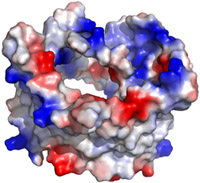Announcement
September 4, 2008

Structure of VDAC1. Courtesy of Gerhard Wagner, Harvard Medical School.
Researchers led by Gerhard Wagner, Ph.D., of Harvard Medical School have determined the structure of a human membrane protein involved in metabolism and the self-destruction of cells—two biological processes central to health. Results appear in the August 29, 2008, issue of Science.
The Wagner team has solved the structure of the pore-forming protein VDAC-1. This molecule is found in the outer membrane of mitochondria, the power plants for eukaryotic cells. It mediates the flow of small molecules into and out of mitochondria. In particular, it is responsible for exporting ATP, the major currency of cellular energy, out of mitochondria.
The structure confirms what earlier studies had suggested: VDAC-1 interacts with proteins that inhibit apoptosis, or cell death. Apoptosis is a natural and necessary process, but too much or too little can lead to diseases such as Alzheimer’s and cancer. The detailed structure shows how these molecules interact and could lead to new research on apoptosis.
Membrane proteins such as VDAC-1 represent one-third of human proteins and more than half of all drug targets. Understanding their structures could aid the design of new pharmaceutical treatments that enhance or inhibit the proteins' function.
“Only a small number of structures of membrane proteins have been determined,” said Jeremy M. Berg, Ph.D., director of the National Institute of General Medical Sciences (NIGMS), a component of the National Institutes of Health (NIH). “This work demonstrates that a different set of methods can yield an important structure in spectacular detail and highlights the importance of supporting the development of novel techniques.”
The grant that supported this research was administered by NIGMS through the structural biology initiative of the NIH Roadmap for Medical Research.
